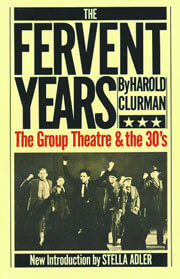Phoebe Brand, at 96, recalls The Group, now memorialized by playwright Ronald Rand
“The Group” is a full-length script by Ronald Rand about the founding of the Group Theatre, the pioneering handful of actors, directors, and playwrights who in the bleak 1930s moved American drama into the gristle of the 20th century. In its short life, about a dozen years, the Group had its impact on everything that followed in American theater, especially the kind of acting that would one day give us a Julie Harris, a Marlon Brando, a Kim Stanley, an Al Pacino, a Meryl Streep, a Robert de Niro.
The play opens with the Group in formation at a summer retreat in Connecticut. An ingénue named Phoebe Brand has rescued a baby sandpiper and hands it to playwright Clifford Odets, who says: “It’s so beautiful! Look, he’s looking at me!”
Odets, who gave the world “Waiting for Lefty,” “Awake and Sing,” “Golden Boy,” “Rocket to the Moon,” and more, left us in 1963, but Phoebe Brand, at 96, is very much with us, in an apartment right on West 43rd Street. In an interview, during which playwright Rand was on hand, she remembered everything including the tumultuous, historic opening night of “Waiting for Lefty,” January 5, 1935, at the old Civic Repertory Theater on West 14th Street.
“That was an affair to remember,” she said of the first performance of the Odets hammer blow about a starvation-driven taxi drivers’ union meeting under the thumb of management goons. It ended with cries of “STRIKE! STRIKE!” by actors and audience, sparked by a young Elia Kazan.
This was the same Elia Kazan to whom and of whom, to the end of his life, Brand would never again speak except with quiet fury—the Kazan who’d named names, including hers and that of her husband Morris Carnovsky, during the invidious House Un-American Activities Committee years of the early 1950s.
“In that rickety theater, the people were stomping in the balcony. I thought the building was coming down,” the actress recalled. There was also a huge jam on 14th Street. “All those cheering taxi drivers. The police stopped them. The crowds were too big. The police were hitting people with their billy sticks, and the people ran.
“When we [the actors] went out on the street, people came up to us and asked: ‘How could you do that?’ [be so real on stage]—marvelous!’ “
In that first production, “Sid” and “Florie,” young dreamers trapped in the grip of grim economic reality, were Jules Garfield (later renamed John Garfield by Hollywood) and Phoebe Brand.
She laughed as she spoke of a scene between actors Tony Kraber, as a dedicated young research scientist, and her future husband Carnovsky, as the lab administrator who tries to get the younger man to squeal on any radical associates.
“At the end, the man Morris played says: ‘No hard feelings?’ And the character Tony Kraber played says: ‘Sure, hard feelings.’ With that [in the heat of performance], Tony punched Morris in the nose, and broke his nose. Such a beautiful nose!” Brand said.
A photo of Brand’s late husband when he appeared as King Lear adorns one wall of the 43rd Street apartment, across from a signed program of Edwin Booth as Hamlet.
“A doctor set the nose in the dressing room. Morris played the whole rest of the show bleeding,” she recalled.
No, broken noses weren’t a common occurrence in the Group. Broken relationships, broken feelings often were.
The Group often had productions and would-be productions in progress at the same time.
“At the same time as ‘Waiting for Lefty,’ we were rehearsing ‘Johnny Johnson’ [the Paul Green/Kurt Weill anti-war musical] up in the country at Pinebrook, Connecticut,” Brand related. “Kurt Weill was there. Lotte Lenya was there… It was on the side that we were doing ‘Waiting for Lefty,’ kind of off-the-cuff. We didn’t know if it would be any good. Clifford wrote that play in two weeks’ time. No changes. Brilliant.”
The triumvirate that started the Group Theatre, coming over from the Theatre Guild, was Lee Strasberg, Harold Clurman, and Cheryl Crawford. All three are now gone.
“That summer [of 1934] we also did one act, the last act, of ‘Awake and Sing’”—the great Odets play about the Berger family of the Bronx, and Grandpa Jacob (Carnovsky, in his late 30s playing a man in his 70s) who passes along to grandson Ralph (Garfield) the passionate injunction: “Go out and fight so life shouldn’t be printed on dollar bills,” one of the ringing lines in all American literature, never mind drama.
“Clifford was from Philadelphia,” Brand said. “He was a stranger here. He came and fell in love with New York. He’d walk around”—she acts it out—”saying: ‘Oh, what a beautiful building!… Oh, what a beautiful subway!’ He used to listen to everyone and write everything down.”
The original production of “Awake and Sing,” at the Belasco Theater, in February 1935, had, in addition to Carnovsky and Garfield, Stella Adler as Bessie Berger, powerhouse of the family; Brand as her restless, unsatisfied daughter Hennie; Sanford Meisner as Hennie’s nebbishy, greenhorn, unloved husband; Art Smith as her ineffective, daydreaming father; and Luther Adler as Moe Axelrod, the caustic boarder who’d lost a leg in World War I and for whom Hennie ultimately leaves husband and child.
At the Act I curtain, Moe Axelrod gropes in a fruit bowl and explodes: “What the hell kind of house is this it ain’t got an orange!” When the show reached Chicago, the audience was not friendly.
“They threw oranges and apples,” Brand recalled. “I was hit by a grapefruit. Stella stepped forward and said: ‘These are your actors. You have to protect them.’
“Arthur Miller saw that production in Chicago. He has said it made him want to write plays. He even remembers the color of the refrigerator. People are always reviving ‘Awake and Sing,’ but they don’t get it, don’t get the poetry.”
Odets’s “Awake and Sing” was in fact almost strangled in its cradle, when Strasberg turned thumbs-down on it.
“Lee stood up and said: ‘Clifford, we don’t like your play.’ But Stella said: ‘Lee, we like that play.’ She saved it. And then Harold said: ‘Let’s all take time off, and come back in the fall, and I’ll direct it.’ What nerve [by which she meant courage] Harold had! He had never directed anything.”
Ronald Rand studied under, and reveres, Harold Clurman. In addition to the full-length “The Group,” which gets a reading June 29 at the American Academy of Dramatic Arts (featuring John Martello, the executive director of The Players theater group, and actor David Pressman, among others), Rand wrote the one-man “Clurman” that’s he reprised in performance this past weekend at the Phil Bosakowski Theatre on West 45th Street.
Rand believes that Strasberg didn’t like “Awake and Sing” because it was too close to Strasberg’s own Lower East Side family background.
Brand on the other hand connected to the play despite her lack of a cultural link.
“I had no relationship at all to Hennie, I wasn’t even Jewish,” she said. “It was Harold who gave me the action that saved me.”
In all the long years of the blacklist—what Stefan Kanfer calls “The Plague Years—Brand and Carnovsky, wife and husband, established formidable careers as acting teachers.
In Brand’s apartment, listening in, Rand inquired tongue-in-cheek: “What was so good about Morris?”
“You have to ask? He was gorgeous!” Brand cried. “He looked like an actorovich! I teach Morris’s method, based on three things: The self, the object, and action between those two.
“With The Group, I met Stanislavsky,” Brand continued. “He was not dogmatic; he was an investigator, same as Morris. Morris was studying acting till the day he died.
“To find yourself is the hardest thing to do. My students, when they find themselves—with simplicity—they don’t try to act. It’s not that they should do less. They should do more in a different way.”
Phoebe Brand, whose father was chief mechanical engineer for Remington typewriters, was born in Syracuse and brought up in Ilian, New York and Stamford Connecticut.
“My mother loved theater, adored it,” she recalled. “She took me to see Maude Adams in ‘Peter Pan.’ I saw ‘Snow White and the Seven Dwarfs.’ I saw Duse! I saw Pavlova! I saw Barrymore’s ‘Hamlet’—gorgeous.”
As a very young woman, Brand auditioned for Winthrop Ames, founder/director of an American Gilbert & Sullivan company.
“I opened my mouth and nothing came out,” Brand recalled. “Mr. Ames said: ‘Never mind, darling, you’re in.’ I heard from other people, he fell in love with me the minute he saw me. For two years I played a lot of princesses with that company.”
Brand then auditioned for Cheryl Crawford at the Theatre Guild. Like Winthrop Ames, Crawford said: “Okay, you’ve got it”—”and Lynne Fontanne worked with me and said: ‘You’re going to be a big actress.’ “
The invitation to join the Group came in a letter from Clurman to Phoebe Brand and 30 others. The new adventure in American theater didn’t even have a name yet.
“I packed just one suitcase. I was thrilled,” Brand recalled. “We all said, ‘Thank God! We’re all going away to the country and we’re going to build a theater.’”
Clurman directed many stunning plays and wrote a crucial book, “The Fervent Years,” a biography, so to speak, of The Group. More than once in his life, not least during the construction of Lincoln Center, he was heard to say: “You don’t start a theater with a building. You start with an idea.”
The Group Theatre was an idea, and still is.
We also publish:



































